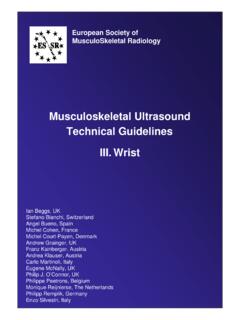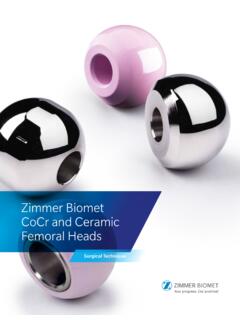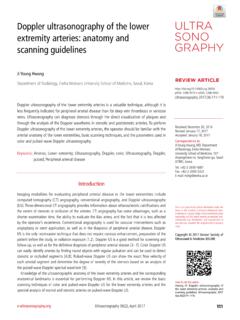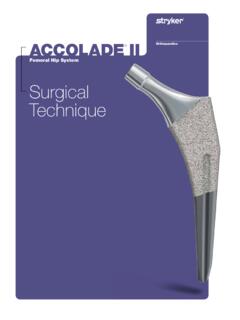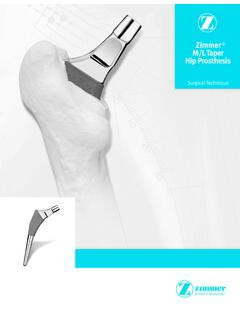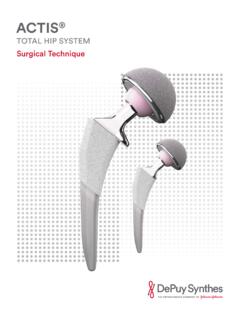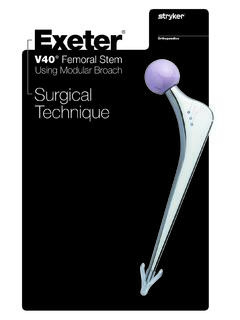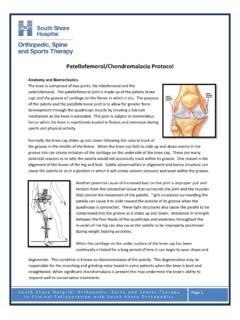Transcription of Musculoskeletal Ultrasound Technical Guidelines V
1 European Society of Musculoskeletal RadiologyMusculoskeletal UltrasoundTechnical GuidelinesV. KneeIan Beggs, UKStefano Bianchi, SwitzerlandAngel Bueno, SpainMichel Cohen, FranceMichel Court-Payen, DenmarkAndrew Grainger, UKFranz Kainberger, AustriaAndrea Klauser, AustriaCarlo Martinoli, Italy Eugene McNally, UKPhilip J. O Connor, UKPhilippe Peetrons, BelgiumMonique Reijnierse, The NetherlandsPhilipp Remplik, GermanyEnzo Silvestri, ItalyThe systematic scanning technique described below is only theoretical, considering the fact that the examination of the knee is, for the most, focused to one quadrant only of the joint based on clinical anterior aspect of the knee is examined with the patient supine.
2 A knee flexion of approximately 20 -30 obtained by placing a small pillow beneath the popliteal space stretches the extensor mechanism and avoids possible anisotropy related to the concave profile that the quadriceps and patellar tendons assume in full extension. 1 KneeSagittal US images obtained in the midline while keeping the distal edge of the probe over the patella display the quadriceps tendon. On long-axis and short-axis planes, observe the multilayered appearance of this tendon due to the close apposition and distal union of the three tendon layers arising from the bellies of the quadriceps femoris muscle.
3 The ability to discriminate among the individual tendon components has practical value to allow differentiation between full-thickness (three layers involved) and partial-thickness (one/two layers involved) tears. Shifting the transducer cranially on axial planes, the myotendin-ous junctions of the quadriceps femoris can be appreciated: the one of the rectus femoris is located at a more proximal level compared with those of the vastus muscles. VlatVintVmed Legend: arrows, quadriceps tendon; 1, superficial layer (from rectus femoris); 2, intermediate layer (from vastus lateralis and vastus medialis); 3, deep layer (from vastus intermedius); F, femur; P, patella; Vlat, vastus lateralis muscle; Vmed, vast-us medialis muscle; Vint, vastus interme-dius muscle 2 Deep to the distal third of the quadriceps tendon, the suprapatellar fat pad is found just cranially to the patella.
4 Immediately superficial to the femur, the prefemoral fat pad ap-pears as a large hyperechoic space. The suprapatellar synovial recess lies deep to the quadriceps tendon and the suprapatellar fat pad and superficial to the prefemoral fat; in normal states, it appears as a thin hypoechoic S-shaped space. Dynamic scanning du-2 KneeImaging should be extended over the lateral and medial sides of the quadriceps tendon because small synovial fluid tend to accumulate in the lateral and medial parts of the suprapatellar recess (which are dependent with the patient supine) and within the parapatellar recesses.
5 With full knee flexion, the femoral V-shaped troch-lea and the overlying ar-ticular cartilage are exa-mined on axial planes. In this position, the quadri-ceps tendon is pushed anteriorly by the femoral trochlea and assumes a curved course over isometric contraction of the quadriceps or squeezing the parapatellar recesses with the non-examining hand may be helpful to detect small effusions. If needed, compression with the probe may help to ** differentiate effusion and synovial thickening.
6 Legend: arrows, quadriceps tendon; asterisks, suprapatellar synovial recess; 1, suprapatellar fat pad; 2, prefemoral fat pad; F, femur; P, patella Legend: arrowheads, lateral parapatellar recess; arrows, medial patellar retinaculum; F, femur; P, patella3** Legend: arrows, articular cartilage of the trochlea; qt, quadriceps tendon ! " 3 The medial and lateral retinacula are imaged on each side of the patella by means of axial planes: they appear as bilayered structures that cannot be discriminated from the underlying joint capsule.
7 An attempt to evaluate the medial articular facet of the patella with US can be made by tilting and pushing the transducer internally while keeping the knee extended. The lateral facet is not visible with US. 3 KneeCheck the prepatellar bursa, which is located over the lower pole of the patella and the proximal patellar tendon: in normal conditions, the bursa is not visible with US. Avoid excessive pressure with the probe over this bursa not to squeeze the fluid away from the field-of-view of the US image.
8 Much gel may help to avoid excessive pressure on the bursa with the patient s positioning described at point-1, examine the patellar tendon from its cranial origin down to its distal insertion using long- and short-axis planes. Because the lower pole of the patella has a V-shaped appearance, one should be aware that the tendon inserts not only on the apex but also along the inferolateral and inferomedial edges of the bone. Short-axis US images over the proximal patellar tendon should be also performed because tendinopathy may occur out of the midline.
9 Deep to the patellar tendon, look at the intracapsular Hoffa fat pad and check the deep infrapatellar bursa between the distal patellar tendon and the anterior aspect of the tibial epiphysis. Mild distension of the bursa appears as a small triangular hypoechoic area and should be regarded as normal. Normally, the superficial infrapatellar bursa is not visible. ** # Legend: arrowheads, medial patellar retinaculum; asterisks, articular cartilage of the medial facet of the patella; P, patella $! $! Legend: arrowheads, patellar tendon; arrow, deep infrapatellar bursa; Hfp, Hoffa fat pad; P, patella " !
10 5 For examination of the medial knee, the patient is asked to rotate the leg externally while maintaining 20 -30 of knee flexion. Place the transducer obliquely-oriented over the long-axis of the medial collateral ligament. Care should be taken to examine the entire length of this ligament. Dynamic scanning during valgus stress can improve the assess-ment of its integrity. Check the soft-tissues immediately superficial to the base of the medial meniscus. 4 KneeFollow the profile of the medial collateral ligament distally and then rotate the transducer forward to image the tendons of the pes anserinus complex (sartorius, gracilis and semitendinosus) in their long-axis.


